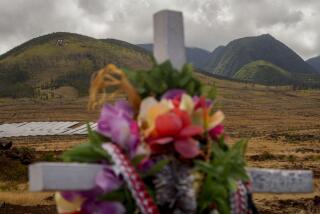The Liberation of Hawaii? : 100 Years After the U.S. Toppled the Islands’ Last Monarch, Native Hawaiians Demand Self-Government--or Even Independence
- Share via
HONOLULU — Most Americans who come here probably know when Pearl Harbor was bombed--or can find out with the flick of a travel brochure.
But how many tan-obsessed tourists--groggily extruding themselves from narrow seats in crammed jumbo jets for respites in paradise--know that the last monarch of the sovereign Kingdom of Hawaii was overthrown by a group of U.S. sugar planters and businessmen backed by 162 United States Marines?
Not many, it seems safe to say.
Yet today, exactly 100 years after that bloodless but bitter usurpation--which led to Hawaii’s annexation by the United States and, ultimately, to its statehood--it is almost inescapable.
In recent months only the most blissed out visitor could avoid the media barrage surrounding the buildup to this local day of infamy. The reason: Many of the state’s 200,000 native Hawaiians have adopted this weekend’s centennial of the ouster of Hawaii’s last queen as a crucial rallying point in their struggle for some measure of independence.
“We are the only native Americans made to wear the yoke of perpetual wardship,” asserts Mililani Trask, an attorney and prominent sovereignty activist.
All in all, the buildup has injected a serious, almost tense, note into these reputedly carefree islands. And one recent minor episode illustrates the increasingly politicized atmosphere. Ten days ago, a native Hawaiian member of the state’s Shark Task Force resigned, charging that the group promoted shark hunting, an insult to Hawaiian religion in which sharks are sometimes viewed as gods.
A few years ago, the resignation would have been viewed as, well, nuts. But within the past decade, sovereignty has evolved from a lunatic-fringe subject into a respectable topic for the family dinner table.
The emergence follows a Hawaiian cultural resurgence that began in the 1970s and the state’s 1978 establishment of the Office of Hawaiian Affairs. Now, politicians eagerly court sovereignty groups. So do businessmen, particularly in the huge tourist industry, which has held briefings for its executives on sovereignty issues.
Generally, the sovereignty movement seeks federal recognition of Hawaiians as a native group, compensation for past wrongs and granting rights of self-government similar to those held by American Indians and Aleuts. Currently, Hawaiians, a minority of the state’s ethnically diverse 1.2 million residents, have no such rights and cannot bring suit as a group in federal courts over such issues as land claims.
Even the definition of who is a true Hawaiian is changing. By official identification, a native Hawaiian used to be a person with 50% or more Hawaiian blood. But three years ago, in a move to increase their political clout, native Hawaiians voted to include anyone with a single drop of Hawaiian blood. Under that definition, native Hawaiians boosted their numbers from about 80,000 to more than 200,000.
And native sovereignty groups have coalesced to bring a semblance of unity to their efforts. Individually, these groups have generated intimidating stacks of sovereignty models, including constitutions. Some try to live by these paper models, signing up “citizens,” holding elections and establishing courts to mediate disputes among members.
Popular culture has also adopted the cause. One radio station here bills itself as “Radio Free Hawaii,” while Hawaiian music, much of it celebrating Hawaiian independence or native lifestyles, is a staple of the airwaves.
Moreover, it is a widely held article of faith that sugar barons and their backers stole a country in the 1893 takeover, sparked by Queen Lili’uokalani’s intention to promulgate a new constitution that plotters saw as a threat to American interests. (At the time, Hawaii was an independent nation recognized by other foreign countries, including the United States.)
Across Hawaii, the overthrow was slated to be commemorated this weekend, particularly in Honolulu’s downtown, where the ornate royal palace now stands overshadowed by glittering high-rises. Here, the observance--a sort of teach-in with elements of pageantry--offers a panoply of historical remembrance that includes speeches, a marathon re-enactment of the coup, church services and a torchlight march.
“If a person is an Hawaiian like I am and grew up here . . . it’s a very sorrowful thing,” says Dallas Vogeler, director of the re-enactment, a pageant composed of five acts and spread over three days.
“We know we’re going to get sovereignty. . . . We’ve earned it. We deserve it.”
Says Murray Towill, president of the Hawaii Hotel Assn.: “This is a communitywide issue. There was a wrong committed with the overthrow that needs to be corrected. The whole community, including the visitor industry . . . needs to be supportive, make sure that we are all aware of it, understand the issues.”
Meanwhile, Gov. John Waihee writes in this month’s Honolulu magazine, “The overthrow of the Hawaiian monarchy . . . was a hostile act, an armed takeover of a legitimate government that was an established member of the community of nations.” (After the queen’s ouster and imprisonment, President Grover Cleveland called the act illegal but Congress failed to nullify the takeover. More recently, the Bush Administration refused to recognize Hawaiians as a native group. Hopes are now pinned on the in-coming Clinton Administration, which has pledged “a more sympathetic ear.”)
Waihee, the state’s first governor with native Hawaiian ancestry, also notes, “The anniversary of the overthrow focuses attention on the question of self-determination, but provides no easy answers on how to restore it or the form that it should take.”
*
That’s putting it mildly.
The widespread surface support for sovereignty fails to mask deep divisions within the movement itself.
A small minority advocates total independence, in effect re-creation of the old kingdom. An even smaller minority has gone on record for total independence coupled with expulsion of many non-natives, a position that is given no chance of success. A broad middle of native Hawaiians argues for a “nation within a nation” status, with natives exercising control over vast but ill-defined tracts of land. Others are wary of turning back the clock, worrying that sovereignty, especially total independence, would spawn a host of economic and political problems.
Dennis (Bumpy) Kanahele, 38, is perhaps the most widely known supporter of an independent Hawaii. Five years ago he helped lead a two-month occupation of unused public land on the coast of Oahu. Tensions between occupiers and authorities peaked when Kanahele’s group armed itself against what it perceived as heavy-handed police presence.
The standoff ended peacefully but Kanahele says he spent nearly a year in prison on a variety of charges relating to it. Then last June, Kanahele and 31 others were arrested during a demonstration at Iolani Palace. Trespass charges were later dropped, but only after massive local publicity.
Today, Kanahele, whose tattoos and 300-plus pound weight are imposing, says he is considerably mellowed. Affable and relaxed, he insists that his group, the Ohana (Family) Council of the Hawaiian Kingdom, is peaceful and that he has good relationships with authorities.
He and his group live and work out of a donated house in Waimanalo, not far from where the 1988 standoff occurred on Oahu’s eastern tip.
Kanahele’s office is a den of activity. While other council members work at word processors, answer phones, sit silently smoking cigarettes or weave palm-leaf hats, Kanahele discusses his desire for independence.
“Lithuania is a perfect example of where we’re headed right now,” he says, referring to the Baltic nation formerly a part of the Soviet Union.
Kanahele and other independence backers pin their hopes on Article 73 of the United Nations Charter, which charges member states with protecting and eventually granting self-government to “non-self-governing territories.”
While critics argue that Hawaiians are no longer covered by this article because Hawaii was granted statehood in 1959, separatists contend that statehood is merely a convenient ruse to gloss over past wrongs.
*
Attorney Trask is perhaps the best known middle-of-the-road sovereignty advocate. Trask and the group she leads--Ka Lahui Hawai’i (The Nation of Hawaii), a self-styled nation with 14,000 “enrolled citizens”--also are representative of native efforts to practice limited self-government.
Trask, 41, says her group’s peaceful stance stems partly from deeply held conviction and partly from pragmatism.
“Under American law any group, native or non-native, that moves toward independence . . . is guilty of treason. . . .,” she explains. “The history of America demonstrates that any insular group that has sought greater independence has been crushed and eradicated. And this is the general principle of American law, without regard to race. When the Southern states wanted to secede it was Civil War and (hundreds of thousands) of men were killed. And they were not black, they were not Indians, they were white people.”
Trask, elected governor of her nation two years ago, adds, “I’m not in a position of having my people get killed behind a secessionist movement. I can’t do it.”
Furthermore, Trask is deeply concerned that “irresponsible talk” by militant separatists “has created a lot of fear.” After one leader recently suggested that non-Hawaiians ought to be forced out, Trask said she was besieged by calls, especially from the large Japanese community. One such group called to ask if Japanese would be put in internment camps, she recalls. Subsequently, Trask says she spent three hours on a Japanese talk radio program trying to soothe the community’s anxiety.
Still, Trask believes the potential for limited sovereignty is great.
Ka Lahui Hawai’i’s constitution provides for citizenship enrollment procedures, election of a unicameral legislature and an executive, and a judicial system for resolving private disputes.
The group has almost no resources and its judges sometimes are hard-pressed to find a place to meet for mediating disagreements.
“Just two months ago I had a big disagreement. . . . I had to get both parties to go into McDonald’s and meet with a judge in a public eating place because we don’t have a place,” she says.
The nation also emphasizes traditional practices as a way of establishing its identity and keeping native ways alive.
For example, disputes may not only be resolved by mediators but also by native elders who may prescribe a 10-day ritual of fasting, cleansing, prayer and discussion to settle disagreements. At the end of the ritual “both sides agree to take their problem and bury it in the depths of the ocean so that it will never rise again,” Trask says.
Resolving the sovereignty issue will be a good deal thornier. And the ultimate solution will turn on complex issues regarding land now held, used or administered by a host of federal and state agencies. These include about 200,000 acres designated as Hawaiian homelands and roughly 1.2 to 1.4 million acres of former crown lands ceded by the federal government when Hawaii was admitted as a state.
To attain nation-within-a-nation status, native Hawaiians would have to exercise some authority over these holdings. But the land trusts are muddy affairs. Much acreage has been leased to private business or become public domain, according to a variety of sources.
The competing interests of natives, several layers of government and private enterprise already are controversial--and promise to become more so.
Vital though they may be, debates over land use and revenue tend to ignore the attitude many native Hawaiians hold toward their islands as mystical, enchanted places.
“In a lot of ways, the regular American thing doesn’t work for us,” says pageant director Vogeler.
“We just don’t fit. . . . We talk to trees. . . . We have to take care of this land.”
More to Read
Sign up for Essential California
The most important California stories and recommendations in your inbox every morning.
You may occasionally receive promotional content from the Los Angeles Times.









